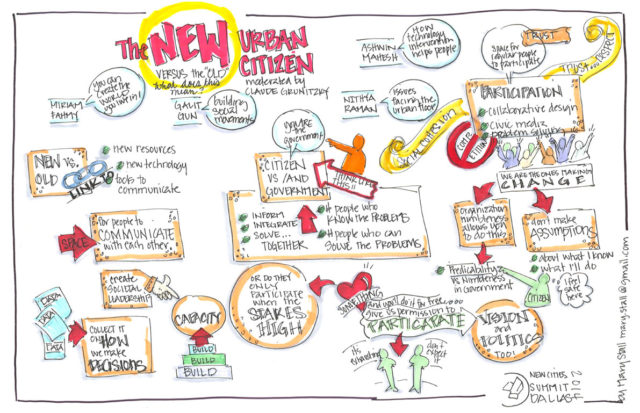The New Urban Citizen
November 25, 2014 — Blog
This post is part of our Re-imagining Cities discussion series, following the third edition of the NewCities Summit in Dallas in June 2014.
Nithya Raman began and claimed that the New Urban Citizen is the same as the Old Urban Citizen, but with access to new tools. In response to how the government is helping or hurting society going forward, Ashwin Mahesh gave his unique personal view on government. He defined himself as the government, being a part of the democracy. In his ideal form of government, there would be problem finders and problem solvers in each and every neighborhood, who would collaborate together in order to solve issues unique to them. This contentious theory caused much debate for the rest of the discussion.
Miriam Fahmy then entered the discussion, commenting that we need to redefine what public participation really is. The common type of project that comes to fruition out of meetings of the urban elite are “prestige projects.” While beautiful and magnificent, they don’t take into consideration what they are replacing—possible homes and occupied spaces. There needs to be an avenue for regular citizens to participate in the planning of projects.
The New Urban Citizen is the same as the Old Urban Citizen, but with access to new tools – Nithya Raman
Galit Gun suggested that the government could become more effective through instituting a sort of nimbleness into their structure. The ability to move quickly allows for citizen engagement to occur. However, this fluidity is difficult to achieve in large organizations. One possible solution that Gun suggested was the creation of small pockets of nimble participation, without changing the integral structure of organizations themselves.

Miriam Fahmy slightly disagreed with Gun on her point on nimbleness, saying nimbleness is more apt for the civil society than for governments. In her opinion, the rigidity of governments allows for predictability, which is comforting for citizens. She believes that the flexibility of the government would be better represented in allowing two-way contact with the government and the people.
Speakers
- Miriam Fahmy, Director of Research and Publications, Institut du Nouveau Monde
- Galit Gun, Senior Director of Strategy, Purpose – @galitgun
- Ashwin Mahesh, Founder, Mapunity – @ashwinmahesh
- Nithya Raman, Founder and Director, Transparent Chennai – @nithyavraman
Moderated by: Claude Grunitzky, Founder and Chairman, TRUE 212 – @TRUE_212
